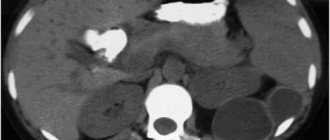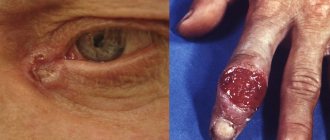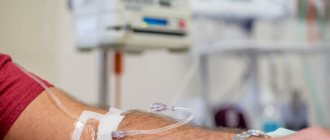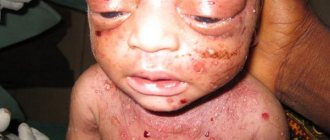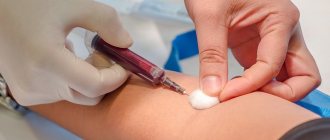This test detects total antibodies to Treponema pallidum, the causative agent of syphilis, and is the most effective and sensitive screening test at the moment.
Total antibodies are a combined study of antibodies of the IgM and IgG classes that are produced by the immune system in response to contact with a pathogen. The first to appear during infection with T. Pallidum (treponema pallidum) is IgM. They can be detected as early as the second week of the disease. Class G immunoglobulins are detected later, 3-4 weeks after contact with infection, but remain in the body at a certain level for a long time (up to a year or more). The maximum concentration of IgG is observed at the 6th week of the disease, when they begin to prevail over IgM.
The test for Treponema pallidum gives a total positive result starting from the 4th week of illness, when a sufficient amount of both types of immunoglobulins is detected in the blood. Thanks to this, this test can be used for the early diagnosis of syphilis. With successful therapy, the concentration of IgG antibodies decreases, but the antibodies do not disappear. IgG antibodies remain in the blood for a long time, therefore, after successful treatment of a previous disease, control studies are recommended, including non-treponemal tests (for example, RPR (qualitative microreaction to syphilis).
Complexes with this research
Pregnancy planning.
Diagnosis of infections 14 tests for expectant mothers 8,620 ₽ Composition Male check-up No. 1 39 studies for annual preventive examination 18,570 ₽ Composition
Entry into IVF Examination when a woman enters the IVF procedure 23,020 ₽ Composition
IN OTHER COMPLEXES
- Expanded hospital complex RUB 7,700
- Preparation for partner childbirth for a man RUB 3,680
- Hospital complex 2,100 ₽
- Examination during pregnancy. 1st trimester 16,690 RUR
- Preparation for IVF for a man 6,060 RUR
Syphilis. Enzyme immunoassay for the detection of total antibodies of class M and G to the causative agent of syphilis
What kind of analysis is this? This is the detection of total class M and G antibodies to the causative agent of syphilis, which can be used as an effective ultra-sensitive screening test for diagnosing early syphilis infection.
At the moment, the Wasserman reaction is considered outdated, and since 2006 it has hardly been used to diagnose syphilis. It has been replaced by more sensitive and modern tests. However, the forms still display the unchanged “RW”. The signature “RW” is a tribute to tradition, a small unspoken rule among doctors: leaving the old signature, they now have in mind new modern tests for syphilis.
What biomaterial can be used for research? Venous blood
Treponema pallidum (treponema pallidum) is a bacterium that causes syphilis, a chronic venereal infectious disease that is most often transmitted sexually, for example, through direct contact with a syphilitic ulcer (chancroid), intrauterine infection is also possible.
The source of infection is a sick person. Syphilis is easily curable, but can lead to serious health problems if left untreated. An infected mother can transmit the disease to her fetus, which may develop serious and irreversible changes.
Syphilis is classified as a classic sexually transmitted disease (sexually transmitted disease). The causative agent is Treponema pallidum. Syphilis is characterized by a slow progressive course. In later stages, it can lead to severe damage to the nervous system and internal organs
Symptoms of syphilis
The symptoms of syphilis are very varied. They vary depending on the stage of the disease. There are three stages of syphilis:
Primary syphilis occurs after the end of the incubation period. At the site of penetration of the pathogen into the body (genital organs, oral mucosa or rectum), a painless ulcer with a dense base (chancroid) appears. 1-2 weeks after the onset of the ulcer, the nearest lymph nodes enlarge (if the ulcer is localized in the mouth, the submandibular nodes enlarge; if the genital organs are affected, the inguinal ones become enlarged). The ulcer (chancroid) heals on its own within 3-6 weeks. after occurrence.
Secondary syphilis begins 4-10 weeks after the appearance of the ulcer (2-4 months after infection). It is characterized by a symmetrical, pale rash over the entire body, including the palms and soles. The appearance of a rash is often accompanied by headache, malaise, and fever (as with the flu). Lymph nodes throughout the body enlarge. Secondary syphilis occurs in the form of alternating exacerbations and remissions (asymptomatic periods). In this case, hair loss on the head is possible, as well as the appearance of flesh-colored growths on the genitals and in the anus (condylomas lata).
Tertiary syphilis occurs in the absence of treatment many years after infection. This affects the nervous system (including the brain and spinal cord), bones and internal organs (including the heart, liver, etc.).
If infected during pregnancy, the child may develop congenital syphilis.
Complications of syphilis
According to scientific research, in the absence of treatment, about a third of patients develop tertiary syphilis. About a quarter of patients die because of it. Congenital syphilis can cause severe damage or death to the child.
Treatment of syphilis
It is quite complex and requires further long-term observation. It is worth noting that treatment of syphilis in the early stages is not particularly difficult in terms of choosing drugs. The peculiarity of Treponema pallidum is that it still retains sensitivity to penicillin , which is the drug of choice for syphilis.
In case of an allergy to penicillin, antibiotics from a number of macrolides (erythromycin, clarithromycin) or cephalosporins (ceftriaxone, etc.) are prescribed. The drugs are prescribed intramuscularly or in tablets. Treatment of active forms of the disease takes place in an inpatient setting; patients with a latent form can receive outpatient therapy. The duration of treatment depends on the stage of the disease and can take from several weeks to several years.
Antibodies to the causative agent of syphilis
When a person comes into contact with T. pallidum, their immune system reacts by producing antibodies to the bacterium. Two types of antibodies to Treponema pallidum can be detected in the blood: IgM and IgG. In response to T. pallidum infection, IgM antibodies to T. pallidum are the first antibodies produced by the body. They are detected in most patients at the end of the second week of the disease and are present in them in the primary and secondary stages. Class G immunoglobulins to T. pallidum appear in detectable quantities in the blood 3-4 weeks after infection. Their concentration increases and in the 6th week begins to prevail over the concentration of IgM, reaching a maximum, and then remains at a certain level for a long time. Starting from the 4th week, the amount of both types of immunoglobulins in the blood increases, which leads to a positive test result for total antibodies to T. Pallidum. This allows this test to be used for early diagnosis of T. pallidum infection. After effective treatment, the concentration of immunoglobulins gradually decreases, but this happens slowly; in some cases, antibodies can be detected after a year or more. Syphilis can be treated with antibiotics, and it is preferable to use penicillin derivatives. At an early stage, the disease is treated easier and faster. Longer therapy may be needed for patients infected for more than a year.
Why is the analysis carried out?
Increasing and decreasing indicators
For the diagnosis of syphilis. For examination of all pregnant women for preventive purposes (preferably at the first appointment with a gynecologist, when registering).
When is the study scheduled? For symptoms of syphilis, such as chancroid on the genitals or throat. When a patient is being treated for another STD, such as gonorrhea. When managing pregnancy, because syphilis can be transmitted to the developing fetus and even kill it. When it is necessary to determine the exact cause of the disease if the patient has nonspecific symptoms that are similar to syphilis (neurosyphilis). If the patient is infected, they should repeat the syphilis test after 3, 6, 12 and 24 months to ensure that treatment has been successful.
Results/Normal/Transcript of analysis
Reference values (normal values)
Result: negative. S/CO ratio (signall/cutoff): 0 - 0.9.
A positive result means that the patient has a recently acquired infection. However, a negative result does not always mean that the patient does not have syphilis.
Positive result
A positive result in a previously seronegative patient, as well as a significant increase in titers in paired sera taken at an interval of 7 days, indicates a primary infection. Detection of antibodies to treponema in the blood of a newborn helps confirm the diagnosis of congenital syphilis. In addition, the cause of a positive result may be tertiary or latent syphilis.
Negative result
A negative test result may indicate the absence of infection or its early stage when an immune response has not developed. At the same time, the absence of antibodies in a baby born from an infected mother does not exclude a congenital disease, since antibodies may not yet have formed at the time of the study.
Preparing for the test
Do not smoke for 30 minutes before donating blood
What can affect the result of the analysis?
False-positive results may occur with diseases such as HIV, Lyme disease, malaria, systemic lupus erythematosus, some types of pneumonia, as well as drug addiction and pregnancy. And many other somatic diseases.
Important Notes
- The examination for syphilis must be comprehensive and include taking into account the medical history, clinical picture and confirmation of the diagnosis by laboratory data.
- People who are sexually active should consult a doctor about any suspicious rashes or pain in the genital area.
- If a patient is diagnosed with infection, he/she needs to inform his/her sexual partner so that he/she can also undergo examination and, if necessary, treatment.
- With syphilis, the risk of contracting other sexually transmitted diseases increases, including the risk of contracting HIV, which leads to AIDS.
• Syphilis can also be transmitted through blood transfusion through contaminated medical instruments, so testing before hospital admission is very important.
Shapilova N.V.
Detailed description of the study
Syphilis is an infectious disease caused by Treponema pallidum. Transmission of infection occurs primarily through sexual contact without the use of barrier contraception. However, it is possible to become infected with treponema pallidum through contact and household contact if personal hygiene rules are not observed, as well as transmission of the pathogen from mother to child during childbirth or breastfeeding. Syphilis can affect any organs and systems. In the absence of timely treatment, the disease becomes chronic. Initially, a hard chancre is formed at the site of contact with the source of infection - a painless ulcer with a small amount of transparent content on the surface. Often the body reacts to the introduction of the pathogen by inflammation of the lymph nodes located near the site of the lesion. Within a few weeks, a scar forms in place of the chancre. However, the disease does not recede, and after some time the infected person notices the appearance of a specific rash on the body - the appearance of small, bright pink spots (rosacea rash). This stage is called secondary syphilis. The disease is prone to periodic exacerbations with changes in the nature of the rash. Tertiary syphilis is the result of untimely diagnosis and treatment of this disease. Along with the formation of nodes and tubercles on the skin, which are called gummas, prone to ulceration and scarring, damage to internal organs is observed. Diagnosis and treatment of syphilis is carried out by a dermatovenerologist. One of the most important diagnostic studies is the detection of immunoglobulins M and G for Treponema pallidum in the blood. This test is the primary screening test for detecting syphilis. If a positive result is obtained, further diagnostics are necessary to determine disease activity.
What do the test results mean?
Normally, the result should be negative. A positive result indicates infection, current or past illness, since the test determines the presence of antibodies to Treponema pallidum. A negative value also does not guarantee the absence of the disease, since antibodies are not produced the first two weeks after infection. If a syphilitic infection is suspected, it is necessary to use non-treponemal and other treponemal tests, and it is also advisable to repeat the analysis after 14 - 21 days.
The test is not used to monitor the effectiveness of therapy, since antibodies can remain for years in the blood of a patient who has previously had a syphilitic infection, has been treated and is currently healthy.
The test can give a false positive result: with non-venereal treponematoses and spirochetosis; as well as in patients with autoimmune diseases, leprosy, cancer, endocrine pathology and some other diseases.
Is this really treatable?
Despite the severe consequences of tertiary syphilis, in the early stages of the disease and in the latent period it is well treated with antibiotics. Treponema pallidum, unlike many other bacteria, still retains very high sensitivity to penicillin and other antibiotics of the penicillin group, so there are usually no problems with treatment. If you are allergic to penicillins, use erythromycin, tetracycline or cephalosporin antibiotics.
Before the discovery of antibiotics, syphilis was historically treated with mercury, bismuth and iodine. These drugs were toxic, ineffective, and such treatment was rarely successful. A real breakthrough in the treatment of syphilis was the discovery in 1908 of salvarsan, an organic arsenic compound. Although it was comparable in toxicity to mercury preparations, it was significantly superior to them in effectiveness, which made the treatment much more successful. Later, less toxic analogues of salvarsan were synthesized - miarsenol and novarsenol, which are sometimes used to treat antibiotic-resistant forms of syphilis today.
Another interesting historical method of treating syphilis is pyrotherapy. Treponema pallidum can reproduce only in a very narrow temperature range - about 37 degrees. When heated to 40–41 degrees, the pathogen already dies. A person can hardly bear such a fever, but it is not fatal. Previously, in order to achieve the required increase in temperature, a patient with syphilis was infected with malaria - the fever it caused led either to a complete cure for syphilis or to a significant slowdown in its development. After this, malaria was treated with quinine.
Currently, pyrotherapy is also used in some cases to treat severe and advanced forms of syphilis, but a special drug, pyrogenal, is used to increase body temperature.
